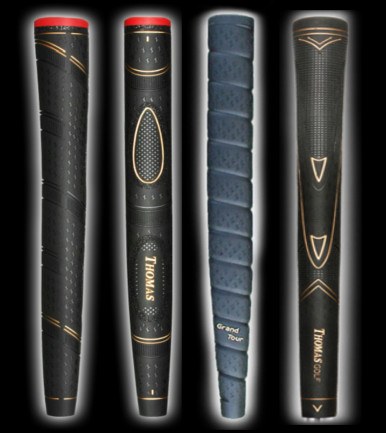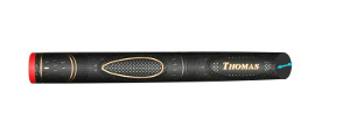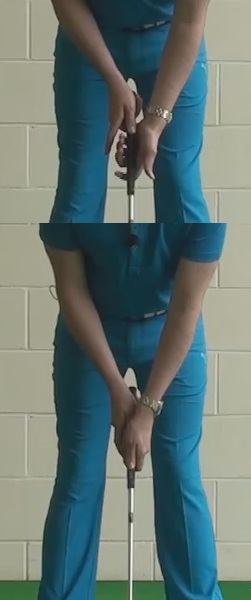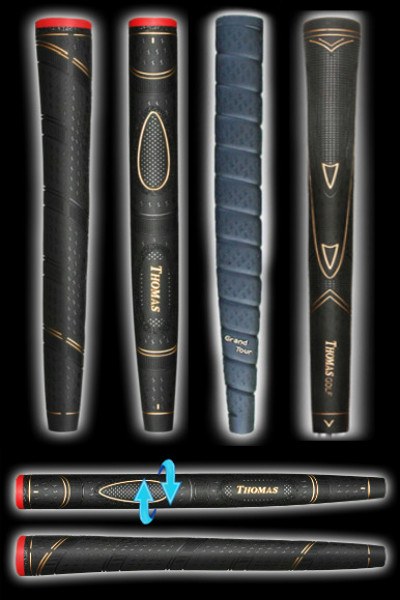
Putting is one of the more unique and personal aspects of golf with a myriad of strokes, stances and hand positions deployed across the world by millions of players.
To match all of these contrasting techniques and of course hand sizes, golfers can now, quite literally, get hold of grips ranging from wafer thin to super jumbo thick. On wedges, irons, hybrids and woods, there is also a host of different grip thicknesses to match different player's needs.
In putting, some grip thicknesses are directly designed to help match some putting strokes and others to help out with a particular putting fault. Very large putting grips, for example, tend to help players who struggle with particularly 'wristy' strokes. On the other hand, very thin grips allow golfers struggling for feel around the green to better judge the distance and line on putts.
As well as fat or thin grips, there is also the grip shape to consider which can also affect the way someone holds the putter and hits the shots. With other clubs, the grip thickness can help influence the way a player moves their hands through the swing. Very thick grips tend to cause a player to have 'quieter hands' meaning they are less likely to turn them over through impact and send a shot left (for a right handed golfer). Very thin grips on clubs will help players who struggle to square the club face up at impact or who find it hard to release the club.
To find the perfect grip for your own game, you should first properly assess your hand size. There are a number of manufacturers such as Ping who have hand charts allowing golfers to measure hand length and span to get custom fit grips. Golfers looking to see if their grips are too thick or thin can use the following test.
Pick up your 7 iron with the left hand. If the fingers of the left hand when wrapped around the grip are pressing into the flesh pad of the left thumb, the grip will be too thin. Golfers should be able to wrap their left hand around the golf club and not press into this flesh pad.
Getting custom fit for your grips is always the best policy with both long clubs and the putter. Experiment with different makes and sizes and seek professional advice. Your grip is the only point of contact between your body and the club, it has to be correct.

Reasons and Benefits for Having Fat or Thin Grips for Clubs and Putters
If you are a serious golfer, you probably spend a fair amount of time thinking about your equipment. While it is true that the right equipment isn't going to automatically make you a good golfer, having the right gear in your bag will make things just a little easier. You don't want to make golf any harder than it has to be, so playing with the wrong clubs would be a big mistake.
When most golfers think about their equipment, they think about club heads and shafts first and foremost. Those are the two most important pieces of the puzzle, but you should not overlook the importance of your grips in this equation. The grip is obviously where your hands connect to the club, and the connection between your hands and the grip is the only opportunity you have to influence the outcome of your shots. If you were to have a faulty connection between your hands and the grip itself, the mechanics of your swing will not be translated properly into the club. In other words, the wrong grip can break your swing.
In this article, we are going to address the topic of grip thickness. This might seem like a rather minute detail at first, but it becomes more and more important the closer you look. Using grips which are a proper thickness for your hands and your game is a key equipment point to watch while assembling your set. Sure, you could ignore this point and play decent golf, but you will never live up to your potential without addressing the issue.
If you were not aware, golf grips come in various sizes to match up with the needs of just about any golfer. In addition to being able to pick out grips in various sizes, you can also use extra grip tape during installation to make your grips thicker if needed. Thanks to the use of grip tape, you can really customize any grip installation to make it match up with your requirements perfectly. A player with big hands may want his or her grips built up to make them more comfortable, while a player with small hands will likely want thin grips and minimal tape. There is no right or wrong on this point, of course, as it all comes down to meeting your own personal needs.
The nice thing about looking at your grips as a way to improve the performance of your clubs is the fact that golf grips are relatively affordable – especially as compared to other pieces of golf equipment like shafts and club heads. A new grip may cost as little as a few dollars, plus a small fee to have the grip installed. In many ways, fitting your set of clubs with new grips will make you feel like you have picked up a whole new set of clubs for a fraction of the price. If you have never before replaced your grips, and you have been using the same clubs for several years, put this point near the top of your to-do list.
All of the content below is based on a right-handed golfer. If you play left-handed, please take a moment to reverse the directions as necessary.

The Importance of Grip Thickness
On the surface, it wouldn't seem like grip thickness was a particularly important issue. It is, however, important for one particular reason – it has a strong influence over the quality of your release at the bottom of the swing. With the right grip thickness on your clubs, you will be able to release the club correctly through impact. Get this equipment point wrong, however, and you will always have difficulty squaring up the club face as just the right moment.
When your grips are too thin, it will be too easy to release the club at the bottom of the swing. Your hands will have tremendous influence over the movement of the club, and that is not necessarily a good thing. You should be able to produce some impressive club head speed this way, but controlling that speed is going to be a challenge. Players with thin grips often wind up with a hook as a result of their aggressive release. The club face will close down rapidly as impact arrives, meaning you are going to need excellent timing if you wish to produce quality shots. Is it possible to play good golf with grips that are too thin for your hands? Sure, it's possible, but it is going to be significantly more difficult than if you were using properly sized handles.
As you might expect, using grips which are too thick for your hands is going to have the opposite effect. Your hands will have a limited amount of input on the club during the downswing with thick grips, meaning it will be harder to release the club head in time to hit the ball solidly. If thick grips are combined with other swing mistakes, you may even find that you are stuck in a slice pattern due to this equipment problem. Thick grips can be just as much of a problem as thin grips, although for different reasons.
Playing with improper grip thickness can also be a problem in the short game. Whether chipping or putting, you need to have a great feel for the club as it swings if you are going to control your distance correctly. The short game is all about distance control, and you may be surprised to learn how much the right grip thickness can help you with this key skill. If you have ever picked up another golfer's putter and thought that it either felt great or terrible in your hands, there is a good chance it was actually the grip thickness you were noticing. We will address the topic of grip thickness in the short game again later in this article.
The main point that you need to take away from this article is the fact that grip thickness is extremely important. Anything that affects your release can have a big impact on your game, as the release is one of the delicate elements of the swing which will either help you succeed or doom you to fail. If you are serious enough about your game to shop for new clubs, test your shafts, etc., you should be serious enough to work on your grip thickness. Once you experience the difference that this point can make, you will regret taking so long to address it properly.

A Simple Test
Unlike when shopping for other pieces of equipment, you don't need to go through a high-tech fitting process in order to find the right grip thickness for your clubs. In fact, there is an easy test that you can perform with your current clubs to check on the status of your grips. Based on the results of this test, you can decide if you need to look into thinner or thicker grips to arrive at an appropriate balance.
To test the thickness of your current grips, follow the steps below –
- Pick one of the clubs from your bag (not your putter, of course) to use for this test. It doesn't particularly matter which club you use, as long as it has a grip which is the same thickness as those throughout the rest of your set. Since you aren't going to be hitting any shots – or even making a swing – you don't need to be at the course to complete this quick check.
- While casually holding the club in your right hand, extend your left arm out in front of you. Your arm should be parallel to the ground, and your hand should be open with fingers extended. Put another way, your hand and arm should be out as if you were going to give someone a handshake with your left hand.
- Next, take the club and place it into your left hand. The club shaft should be perpendicular to your left arm as you put it in place, and the club head should be up in the air. Place the club as if you were getting ready to form your grip and take a swing (even though you are not going to be swinging in this drill).
- With the grip of the club pressed up against your left hand, go ahead and close your fingers around the grip. You will now be able to let go of the club with your right hand, as your left hand will have taken control. The test is now complete, and the only thing left to do is evaluate the results.
If your grips are the proper thickness, the middle finger on your left hand will just barely touch your palm once your hand is wrapped around the grip. This is the indication that you can use for a perfectly-sized grip in golf. For most players, using a grip which will cause the middle finger to barely contact the palm on the other side of the grip is perfect. This is a balance between thin and thick, and it should enable you to make a comfortable, controlled release through impact.
Should you find that your current grips are already putting your hand in this position, you may be finished with this topic. Your grips are already a good fit, and unless there is an obvious reason to make a switch, you can move on. Go ahead and work on other parts of your game in order to improve on your performance. However, if you find that your current grips are not the right size, now is the time to take action.
The best first step you can take when you realize your grips are an improper fit is to visit your local golf shop. Nearly every golf shop in the world will have a collection of grips for you to try out for yourself. Many of these grips will come in 'standard' or 'regular' thickness, but there will be some thin and thick grips available as well. Also, remember that extra tape can be added to customize the feel of your new grips once they are installed.
If you aren't sure how to find the right grips, ask one of the employees at the golf shop for help. Grips are a common topic of discussion in a golf shop, so the staff should have plenty of advice for you. With any luck, you will be able to quickly settle on a new set of grips. When you purchase your new grips from the golf shop, they may offer to install them for free. Even if the installation isn't included, it will typically be offered for a very modest fee.

The Matter of Personal Preference
If you successfully followed the steps above, you should have been able to determine how well your current grips fit your hands. That is a great place to start, and playing with well-fitted grips is always going to be the best option. However, not all golfers choose to play with grips that fit their hands perfectly. Instead, some like to go larger or smaller in order to gain small performance advantages which are specific to their game.
Intentionally going with a thicker or thinner grip is something that will need to be based largely on personal preference. For instance, if you just don't like the feel of thin grips – even though you have small hands – you might decide that thicker grips are the way to go. You probably don't want to stray too far from a standard fit, but tweaking your thicknesses to match with your tastes is perfectly acceptable. You need to be comfortable and confident on the course, and using grips which fit your hands will bring you closer to that goal.
In addition to personal comfort, you can also tweak your grip thickness as a way to alter the shots you produce on the course. Consider the following points when trying to decide on a grip thickness for your set.
- Choose a thicker grip to reduce your draw. If you are constantly fighting with a ball flight that wants to turn too much from right to left, consider using a slightly thicker grip in order to take some of the draw out of your trajectory. You don't need to go dramatically thicker to make a difference – even just a layer or two of extra tape may do the trick. Using a thicker grip will cause the release to slow down at a bit at the bottom, and your draw should be reduced as a result.
- Choose a thinner grip to reduce your fade. This works exactly the same as the previous point, except in reverse. If you are hitting a fade which is a little too dramatic for your taste, switch to thinner grips to make it easier to release the club head through the ball. Even if your swing path does not change, your fade should be reduced thanks to an improved ability to square up the face at impact. There is nothing wrong with playing a fade, but you don't want it to get too dramatic as you will begin to lose significant amounts of distance at some point. With this slight equipment adjustment, you can play the fade you are familiar with while keeping it in check at the same time.
- Choose a thicker grip for added consistency. Some golfers prefer to use thicker grips simply because they make it easier to hold the club steady through impact. With a thick grip in your hands, you may feel more in control of the club head throughout the swing – meaning you should be more consistent overall. There will be less hand action in your swing as a whole when you choose thicker grips. Reduced hand action is strongly associated with consistent results, even if you do give up a little swing speed along the way.
- Choose a thinner grip for better feel. Where thick grips can help you with consistency through impact, thin grips can make it easier to 'feel' your swing from start to finish. Some golfers, those who would classify themselves as 'feel players', value this aspect of the game. By having a great feel for the club head, you may be able to create a variety of different shots which would be off the table with thicker grips. This is a point which is based largely on personal preference, so try out some thin grips for yourself before making a decision.
You may have your own personal reasons for wanting larger or smaller grips than a traditional fit may indicate. Feel free to experiment with both larger and smaller grips in order to get an idea for the differences between these two options. In the end, settle on grips which make you feel comfortable throughout the swing from start to finish.

Grip Size in the Short Game
As was mentioned previously, grip size is important in the short game as it is in the long game. You need to have grips which feel comfortable in your hands when playing short shots, and you need to make sure those grips allow you to control the speed of your swing properly. Perhaps surprisingly, this might mean two different things when it comes to chipping and putting.
For chipping, many golfers will find better results with thinner grips. The reason for this is the ability to feel the club head as it swings through the grass. Since you are using your hands and wrists actively while chipping, a thin grip is going to translate the feel of the club through your hands effectively. Should you opt for a thick grip, less feedback would make it through, and you may struggle to control both speed and the quality of your strike. If you find that you enjoy chipping with thin grips, it is even an option to use a thinner grip on your wedges than you use on the rest of your clubs.
Once you step onto the greens, however, things change. While putting, more and more golfers are finding it beneficial to use thick grips. In fact, there has been a wave of extra-thick putting grips brought to market in recent years due to the popularity of this option. Why are thick grips popular? Simple – they help to take your hands out of the putting stroke. A good putting stroke is controlled by the shoulders alone while the hands and wrists stay out of the way. If you had previously had trouble making this kind of stroke, a thick grip could help you put it all together on the greens.
Since you only need to buy one putter grip to try this method out for yourself – instead of a whole set of grips for your full swing clubs – there is little standing in your way of a test drive when it comes to thick putter grips. Check out the stock at your local golf shop to pick out one that feels good in your hands. Even if you don't wind up using a thick putting grip in the long run, simply practicing with one for a short period of time may have a long-lasting positive impact on the mechanics of your stroke.
If you have not previously thought of grip thickness as being an important issue in your game, you should now be armed with a new perspective. While this might not be the single most important equipment decision you need to make, it certainly is one which deserves some attention. By fitting your clubs with grips that offer a comfortable feel and reliable performance, you will be one step closer to meeting your goals on the course. As a much cheaper alternative to making changes with your club heads or shafts, grip adjustments are a great place to start when you want to review the performance of your set. Good luck!






